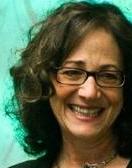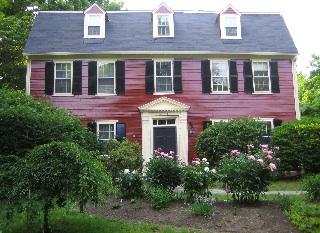
The Samuel Wheat House
399 Waltham Street, West Newton, MA
In about two weeks' time, my house will look like this again. The peonies, which I transplanted from the far edge of the property to the front garden some years ago, always bloom around my birthday, the moment that may be Wheat House's most glorious.
Why Wheat House? Read on. But first: the house is on the market and Boston Globe reporter Eileen McEleney Woods gave it a very nice write-up in Sunday's Globe Magazine. Scroll about halfway down the article and you'll find this description:
PROS Listed on the National Register of Historic Places, the Samuel Wheat House, a pre-Revolutionary Georgian built in 1735, exudes warmth: Much of this gambrel, particularly the kitchen, is sunny, five rooms (including two bedrooms) have fireplaces, and the original wide-plank hardwood flooring is golden. Amid all of this history (the dining room was once used as a doctor’s office, and the original doorway, ornate and stately, still graces the front entrance) are modern conveniences, such as the stainless appliances in the kitchen and the sink in a mudroom closet. It’s a five-minute walk to the commuter rail. CONS Take care pulling out of the driveway.
Thank you, Ms. McEleney Woods. It's heartwarming to read such a glowing description of the abode that our family has loved so deeply for so many years.
There are houses that people live in and there are homes that even the one-time visitor remembers. Looking at comments on my Facebook page where I first posted about the house being on the market, I find a number of visitors who were there perhaps once or twice.
- I will miss your house dearly!
- Love your house.
- The house looks amazing Jessica, I have a lot of fond memories ...
- I have MANY very fond memories of that house, even before you moved in... don' t forget to tell people about the bomb shelter under the back yard!
- I remember that lovely home very well.....and leading the seder at your dining room table during college!
- I will always cherish the first time I went to your home it was wonderful and I love the house.
It's an instant nostalgia machine, a great place for gatherings, and a very easy house to live in. It's also in walking distance of the famed West Newton Cinema, one of Boston's premier movie houses; 10 places to eat including Lumiere, Blue Ribbon, The Local, Shogun, L'Aroma, Comella's, and West Newton Pizza; the commuter rail; the express bus; and at least 45 banks (a new development).
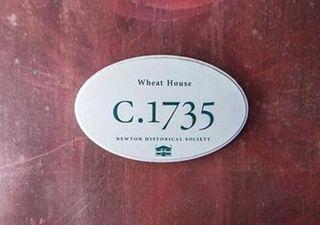
And further to two of the Globe reporter's points: 1. It is indeed sunny because, wisely, those pre-Revolutionary builders knew what solar advocates today seek--it's the only house on the street that faces south (all the rest face east and west); and 2. Yes, when a road is built around a house that went up nearly 200 years before there even were cars, then driveways can be a problem, which is solved by creating a turnaround so you're always facing out.
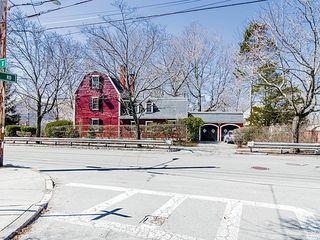
Having lived here for so many years, I know every nook and cranny, every detail, like these facts:
- What is now the den has seven doors (to the second floor, to the cellar, to the china cabinet, to the playroom, to the dining room, to the kitchen, and to the passthrough);
- There are four giant linen drawers outside the second-floor laundry (the best place for a laundry);
- There's a plug in the middle of the dining room floor because that's where the doctors who previously lived here had their offices;
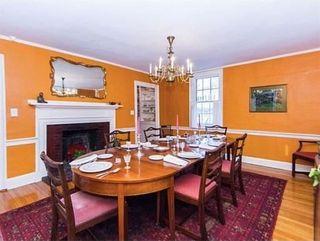
- There's a third floor with a full bath and two bedrooms or studies or studios or whatever you want there that are so far away from the kitchen that it's as if you're in a different building;
- The original horsehair insulation is so good that until it's well over 90 for a few days running you don't even need air conditioning;
- What was the sixth bedroom is now a walk-in closet, making for easy living;
- The closets overall are large, plentiful, and unusually ample for an old house;
- There's a coat closet under the front stairs;
- With six rooms on the ground floor, a hundred people can still circulate at a party;
- The post in the northwest corner of the kitchen is actually a tree trunk;
- The wideboard pine floors (18" and wider) in the former dining room were installed in the early 1800s (you can tell by the nails, one refinisher told me);

- The yard in back feels like a secret garden and, once inside, you have no notice of the street; and,
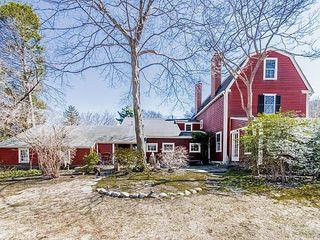
- Bucky Fuller had dinner here on February 10, 1977.
It's a treasure and it's hard to part with.
I pulled together a history of the house for use by the real estate agent (this link takes you to all the pictures). There are relatively few houses in the US with this kind of provenance that have survived intact.
The fine condition of the house is a testament to the quality of the materials and the skill of the original builders. In all the years that we owned it, we never had a major repair, just the typical things that householding brings: painting, replacing appliances, the occasional clogged sink. And so, herewith, culled from a variety of historical records, I offer...
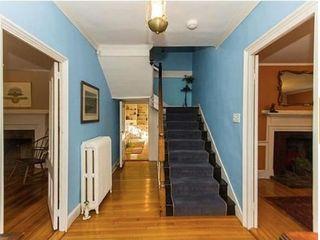
Wheat House, A History
The house at 399 Waltham Street, known as The Samuel Wheat House and named for its first owner, Dr. Samuel Wheat, has been owned by eight families since it was completed in 1735.
Listed in the National Register of Historic Places, this pre-Revolutionary Georgian retains architectural details typical of the period, including a steep gambrel roof and narrow side elevations. Evidence of alteration includes chimney additions and a six-over-six window sash in the 19th century and such 20th-century additions as the garage and library in the 1930s, and the sunroom in 1985. Even with these changes, the house remains remarkably intact and is considered to be of major historical significance.
Samuel Wheat and his wife, Hannah, whose gravestone lists her as a “professor of religion,” were reported to have had 17 children. Dr. Wheat, who came to West Newton in 1713, was the village doctor. First one of their sons, Samuel Jr, and also a doctor, and later their daughter, Catherine, who married Capt. Thomas Eustis, owned the house, which eventually was sold at the turn of the 19th century to the Davis family, perhaps the same people for whom nearby Davis Avenue is named.
Briefly owned by the Woodford family (he was treasurer of Second Church), the house then became the home of Samuel S. Kilburn (a designer and an engraver) and his family, who lived here until the turn of the 20th century. In 1898, Mrs. Edward Augustus Holyoke Allen, moved into the house with her children, following the death of her husband, who was a first cousin of Nathaniel Allen, who taught at the Allen School on Webster Street, where the educator Horace Mann also taught.
In 1929, the house was sold to the Baker family, who made a number of renovations, including turning the woodshed into the library, adding the mudroom, the garage, and the sun porch, removing the side door on Waltham Street, which is now where the shelves are between the dining room and the den, and planting the gardens, many of which specimens still survive. The Bakers owned the house until 1955, when they sold it to Dr. Nick and Joyce Stahl, who were married in the garden.
Mary and Richard Burack (who was also a doctor) bought the house in 1959, raising their five children here. During their tenure, they removed the old bake oven in the den, built the fireplace and paneling that now surround it, replaced the front sill, replaced clapboards on the front of the house, and built a bomb shelter in the backyard.
They sold the house to authors Jessica Lipnack and Jeffrey Stamps on April 18, 1972, three months after they were married, and who renewed their vows in the garden in 1986. While previous owners had previously used the current dining room as a doctor’s office (an electrical plug remains in the middle of the room for the former examination table), the new owners converted several bedrooms to studies where they wrote many books, bringing the first computers into the house when they moved in.
They added storm windows and doors, enclosed the sun porch making it a four-season room, opened an interior window between the kitchen and the den, added 220 wiring throughout, removed all the peeling wallpaper, installed first a woodstove and then a fireplace insert in the den, stripped, stained and polished the mantel around the den fireplace, lined the chimney, replaced the roof, added wood flooring to the kitchen, planted the decorative flower and herb garden in the front yard, added the 1868 bell to the front door, installed brass and porcelain locks on the first floor windows, converted one bathroom to a laundry room, converted a half-bath in the mudroom area to a utility sink for gardening, added Italian glass tiles to the half-bath off the dining room, and returned the house to its original color—red.
They raised two daughters here, Miranda, born in 1977, and Eliza, who was born in the house in 1980; held many gatherings; hosted many weddings and wedding receptions for friends; and celebrated the publication of many books of their own and for those of friends.
Jeff Stamps died at home of pancreatic cancer in June, 2011.
Jessica Lipnack is selling the house after living here for 42 years.
